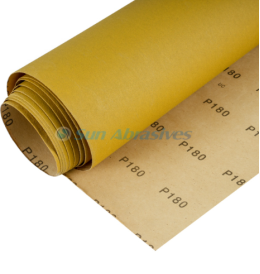Emery Paper: The Quiet Craftsman's Secret Weapon
Time:
2025-07-07 10:19
Source:
Emery paper takes its name from emery, a dark, hard, granular rock that was once the primary abrasive material used in its production. Composed mainly of corundum and magnetite, emery has been prized for its grinding properties since ancient times. However, modern emery paper often relies on synthetic abrasives like aluminum oxide or silicon carbide. These man-made materials offer enhanced durability and consistent performance, making them the go-to choice for most manufacturers today.

The process of making emery paper is a careful balance between science and craftsmanship. First, manufacturers meticulously select abrasive grains based on their size, shape, and hardness. These grains are then evenly spread and bonded to a paper backing using a specialized adhesive. The adhesive must be strong enough to hold the grains firmly in place, yet allow them to release gradually as the paper is used. This controlled release ensures that the emery paper maintains a consistent abrasive action from the first use to the last.
One of the most remarkable aspects of emery paper is its versatility. In the world of woodworking, it’s an essential tool in every craftsman’s toolkit. Whether you’re restoring an antique wooden chair or building a new bookshelf from scratch, emery paper helps you achieve that perfect finish. Take, for example, the process of refinishing a wooden table. A coarse-grit emery paper is used first to quickly remove the old, worn-out finish and smooth out any imperfections. As you progress, you switch to finer and finer grits, each one refining the surface a little more until you’re left with a surface so smooth, it’s almost like glass.
Metalworkers also rely heavily on emery paper. It’s used to remove rust from old tools, smooth out welds on metal structures, and even polish metal surfaces to a high shine. Imagine you’ve found an old, rusty bicycle frame at a flea market. With the help of coarse-grit emery paper, you can quickly strip away the rust and reveal the bare metal underneath. Then, using finer grits, you can smooth the surface and prepare it for painting or plating.
The automotive industry is another field where emery paper shines. Mechanics use it to sand down car bodies before painting, ensuring that the paint adheres properly and creates a smooth, even finish. It’s also invaluable for touch-up jobs, where precision is key. And in the electronics industry, emery paper is used to clean and prepare component surfaces, ensuring reliable soldering and connections.
Understanding the grit size of emery paper is key to using it effectively. Grit sizes range from very coarse, which is great for quickly removing large amounts of material, to extremely fine, which is used for the final polishing stages. Think of it like cooking-you wouldn’t use a sledgehammer to crack an egg, and similarly, you wouldn’t use a coarse-grit emery paper for a delicate finishing job. By choosing the right grit for the task at hand, you can achieve professional-quality results every time.
Related News
undefined



